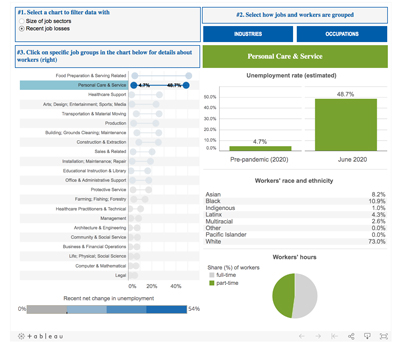 Over the past four-plus months, as the COVID-19 novel coronavirus emerged in Minnesota and the Twin Cities region, Metropolitan Council research staff have analyzed the broader economic impacts of the virus on employment, income, and housing cost-burden.
Over the past four-plus months, as the COVID-19 novel coronavirus emerged in Minnesota and the Twin Cities region, Metropolitan Council research staff have analyzed the broader economic impacts of the virus on employment, income, and housing cost-burden.
The goal is to contextualize the social and economic impacts of employment and income losses following the abrupt closing of businesses and associated downturn in economic activity.
“When the economic aspects of the pandemic and response became evident, researchers jumped in to estimate the impacts,” said Todd Graham, principal researcher. “Our main focus has been households’ economic stress, and the impacts on employment and incomes. Knowing the disparities present in our region, we were concerned that again people of color would bear the greatest impact.”
The stay-at-home order and related economic impacts created an unprecedented drop in economic activity in March. As a result, the region experienced significant job losses, along with the rest of the nation.
Personal care services and food preparation and service jobs hardest hit
The analysis focuses on the industries and occupations most affected by job losses, the impact that has on household incomes and housing cost-burden, and the related impacts on preexisting disparities for people of color in the region.
Initial analysis showed personal care services and food preparation and service occupations were the hardest hit, with more than 50% of employees out of work. In a second set of professions, including building cleaning and maintenance, health care support jobs, arts and entertainment, transportation, and sales work, Met Council researchers project that joblessness will peak at as much as 25%.
Researchers found that people of color generally experienced higher rates of unemployment and income loss as a result of the pandemic than people who identify as White. This is almost entirely attributable to the racial compositions of the most impacted occupations.
The analysis also showed that while a significant percentage of the region’s residents experienced income losses as a result of business closures and slowdowns, relief aid provided through the federal CARES Act has lessened the impact and at least in the early months helped reduce pre-pandemic disparities.
The CARES Act provided direct cash payments for each adult and child, in addition to expanded unemployment insurance benefits, at least through July 31, and through the end of the year for certain eligible workers.
CARES Act funding also helped stabilize housing cost-burden for both homeowners and renters.
The benefits of the CARES Act may be only temporary, particularly as the impacts of the pandemic continue to shift. Ultimately the analysis finds that disparities in economic impacts will remain between people of color and people identifying as White, given that other resources are not as available and people of color are also subject to disparities in health outcomes and risks related to the novel coronavirus.
Researchers will be updating employment data as it comes in from the state monthly and applying the analysis of impacts. View the interactive resources and presentations.
Traffic data analysis also shows COVID-19 impacts
Researchers and data scientists at the Minnesota Department of Transportation (MnDOT) and the Met Council have also been analyzing the impact of reduced traffic throughout the Twin Cities region as a result of the COVID-19 outbreak.
Traffic volumes are down on highways statewide and in the metro area. A snapshot of data from July 13 shows metro area traffic volumes down 19% from typical volumes. During the stay-at-home order, metro area highways volumes were down more than 50%.
Broader Council research on COVID-19 impacts